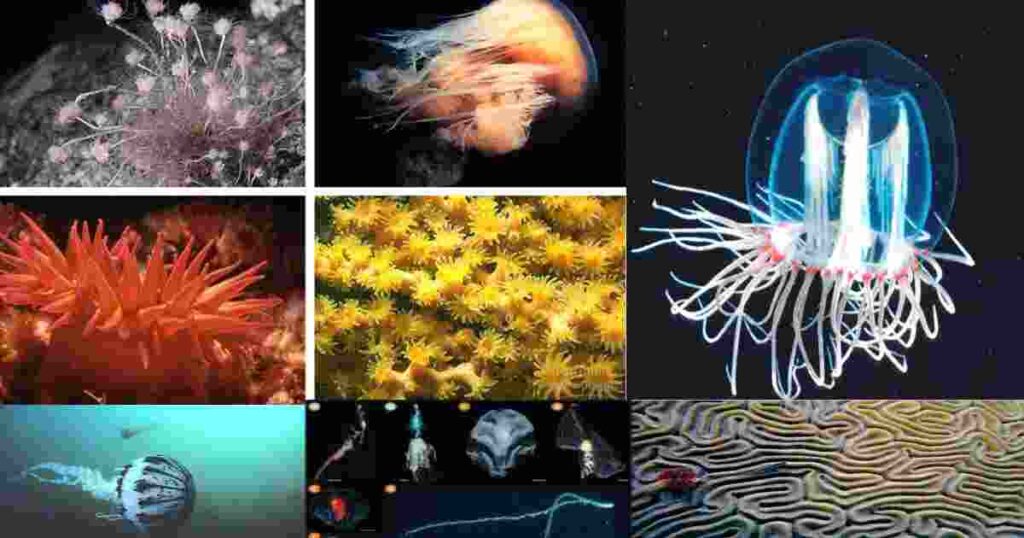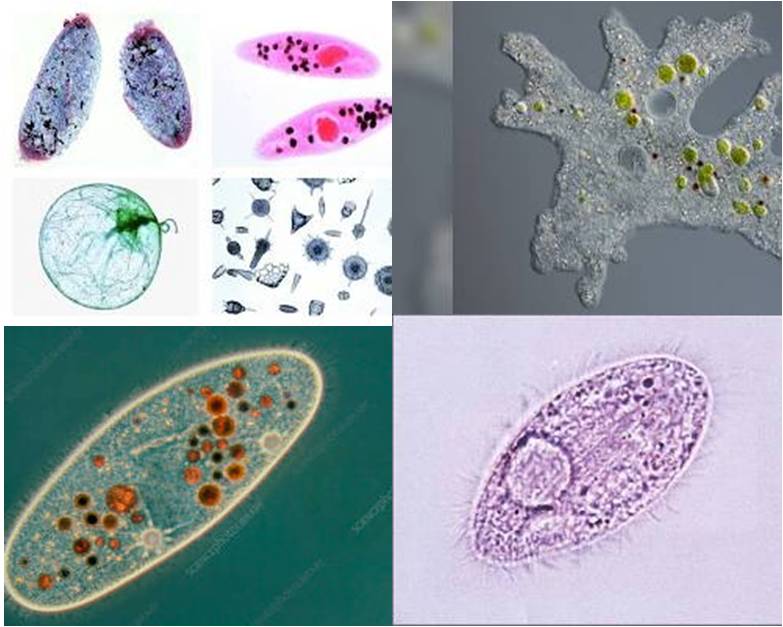Phylum Cnidaria: Cnidaria derives from the Greek word “cnidos,” which means “stinging thread.”
Defination: The cnidaria may be defined as “diploblastic Metazoa with tissue grade of construction having nematocysts and a single gastrovascular cavity or the coelenteron.”
The phylum Cnidaria is a large group of aquatic invertebrates, with over 11,000 described species. They are mostly marine animals, but some species can be found in freshwater environments. Cnidarians are well-known for their stinging cells, called cnidocytes, which they use to capture prey and defend themselves. Their bodies consist of a non-living jelly-like substance called mesoglea, sandwiched between two layers of epithelium that are mostly one cell thick.
General Characteristric of Phylum Cnidaria
- Cnidarian are Metazoa or multicellular animals with tissue grade of organization.
- They are aquatic, mostly marine except few freshwater forms like Hydras.
- They are sedentary or free-swimming and solitary or colonial.
- Individuals are radially or biradially symmetrical with a central gastrovascular cavity communicating to the exterior by the mouth.
- They are diploblastic animals; body wall consists of an outer layer of cells called ectoderm and inner layer of cells the endoderm cemented together by an intermediate layer of non-cellular gelatinous mesogloea.
- Acoelomate animals because they do not possess a second body cavity, the coelom.
- Short and slender tentacles encircle the mouth in one or more whorls.
- The tentacles are provided with nematocysts; tentacles serve for food capture, its ingestion and for defence. These are also present on body layers, these are adhesive organs.
- They exhibit the phenomenon of polymorphism with very few exceptions; the main types of zooids in polymorphic forms are polyps and medusa. Polyp is sessile and asexual zooid, while medusa is free-swimming and sexual zooid.
- Skeleton, either exoskeleton or endoskeleton is of common occurrence.
- They are usually carnivorous; digestion is extracellular as well as intracellular. Anus is not found.
- Nervous system consists of one or more networks or nerve-cells and neurites located in the ectoderm and endoderm.
- Respiratory, circulatory and excretory systems are wanting. 14. Reproduction is both by asexual and sexual methods.
- Asexual reproduction occurs by budding and sexual reproduction by the formation of gametes.
- A ciliated planula larva usually present in the life history.
- The life history exhibits the phenomena of alternation of generations or metagenesis which the asexual polypoid, sessile generation alternates with sexual medusoid, free-swimming
Classification of Phylum Cnidaria
Cnidarians are classified into four main classes:
Class I- Anthozoa (Gr., anthos-flower; zoios animal)
- This group includes sea anemones, corals, and sea pens. They are almost wholly sessile (non-moving) organisms.
- They are exclusively polypoid.
- Medusoid stage is altogether absent.
- Body usually cylindrical with hexamerous, octomerous or polymerous biradial or radio- bilateral symmetry.
- The oral end of the body is expanded radially into an oral disc bearing hollow tentacles surrounding the mouth in the centre.
- The stomodaeum is present, often provided with one or more ciliated grooves the siphonoglyphs.
- Gastrovascular cavity is divided into compartments by complete or incomplete septa or mesenteries.
- Mesenteries bear nematocysts at their inner free edges.
- Mesogloea contains fibrous connective tis- sue and amoeboid cells.
- Skeleton either external or internal.
- Exoskeleton is formed from calcium carbon- ate which often form massive corals.
- Nervous system is in the form of typical nerve net without a concentrated central nervous system.
- Gonads are endodermal, develop in the mesenteries.
- The ripe sexual products are discharged into coelenteron.
- Fertilization is external.
- The fertilized egg develops into a planula larva, which after a short free life settles down and develops into an adult.
Examples: Tubipora, Telesto, Heliopora, Gorgonia, Corallium, Pennatula, Metridium, Admasia, Fungia, Favia, Madrepora, Zonathus, Antipathes Sea anemones etc.

Class II- Scyphozoa (Gr., skyphos = cup; zoios = animal)
- These are the jellyfish, which are swimming forms.
- Scyphozoa include large jelly-fishes or true medusae are exclusively marine.
- Medusae are large, bell or umbrella-shaped, without true velum, free swimming or at- tached by an aboral stalk.
- Marginal sense organs are tentaculocysts having endodermal statoliths.
- Polypoid generation absent or represented by small polyp, the scyphistoma which gives rise to medusae by strobilization or trans- verse fission.
- Gastrovascular system without stomodaeum with gastric filaments and may or may not be divided into four inter-radial pockets by septa.
- Mesogloea is usually cellular.
- Gonads are endodermal and the sex cells are discharged.
Examples: Lucernaria, Charybdaea, Pericolpa, Aurelia,Cyanea, Phyllorhiza punctata etc.
Cubozoa
- These are also free-swimming jellyfish, but they have a cube-shaped body and four tentacles at each corner.
- Box jellyfish are known for their potent venom, which can be deadly to humans.
- Cubozoans have a complex visual system with four rudimentary eyes and a well-developed nervous system.
Examples: Carybdea branchi
Hydrozoa (Gr., hydra= water; zoios =animal)
- A diverse group that includes both freshwater and marine cnidarians. It comprises sessile members (like Hydra) and colonial swimmers (such as the Portuguese man of war).
- They exhibit tetramerous or polymerous ra dial symmetry.
- Body wall consists of an outer ectoderm and an inner endoderm separated by non-cellular mesogloea.
- Gastrovascular cavity without stomodaeum, septa or nematocysts bearing gastric filament.
- Skeleton or horny structure is horny peri- sarc in some forms, while coenosarc sec- retes a skeleton of calcium carbonate form- ing massive stony structure or coral in other forms.
- They exhibit polymorphism. There are two main types of zooids, the polyp and medusa.
- Medusa is provided with true muscular velum.
- Many Hydrozoa exhibit alternation of generations.
- Reproductive products or sex cells are usu- ally ectodermal in origin and discharged ex- ternally.
- Cleavage is holoblastic, embryo ciliated planula.
Examples: Hydra, hydractinia, Tubalaria, Millepora, Obelia, Diphyes, Physalia physalis etc.



